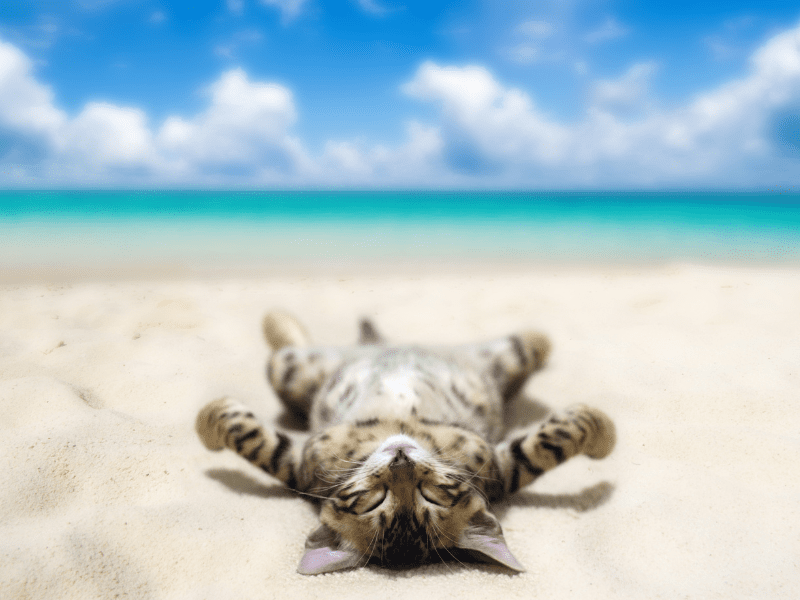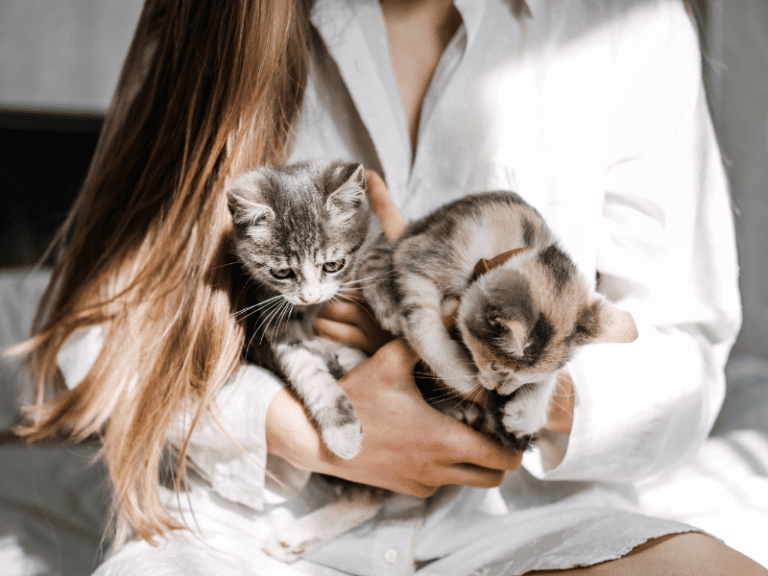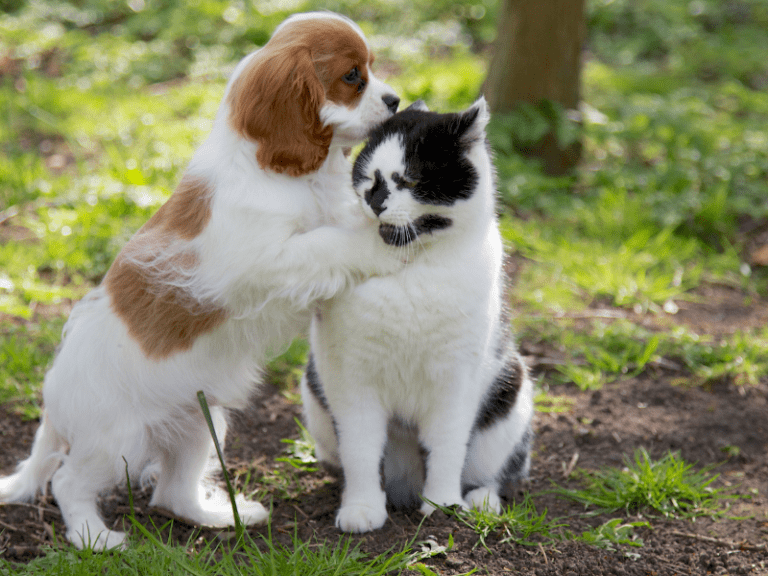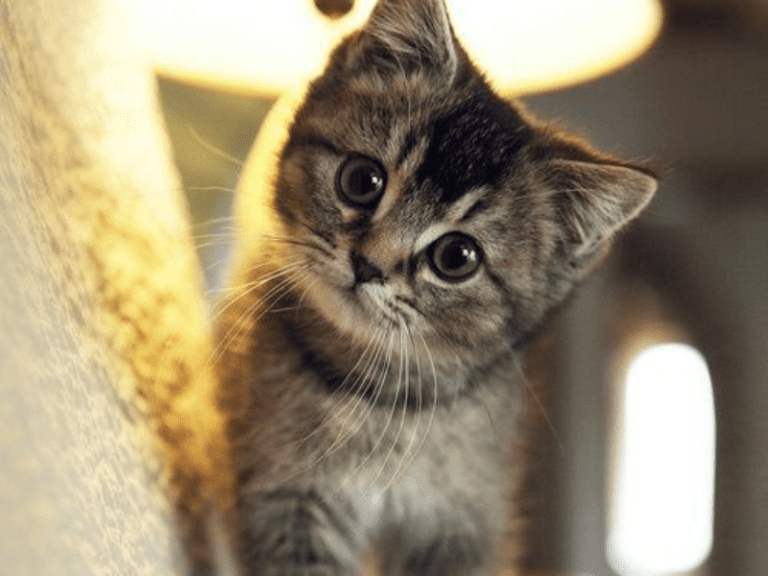Why Cats Don’t Like Water?
FULL DISCLOSURE: The links I share in this course ARE my affiliate links. This means I earn a commission, at no extra cost to you. In fact, sometimes you’ll get a discount or free credits just FOR using my link. 🙂
Cats are quite the enigma, often baffling us with their curious habits and mystifying behaviors. Case in point: their seemingly intense aversion to water.
While you may find some cats that think they're part fish and willingly dive into water, most cats treat H2O like it's a diabolical liquid designed to ruin their day.
So, what's the deal? Why do so many cats dread water?
Buckle up, because we're about to dive into the science behind this feline phenomenon, covering everything from evolution to their unique physical attributes and psychology!
Once Upon a Time in the Desert…

Ever wonder why cats think they're the kings and queens of the animal world? Well, it might have something to do with their ancestors, the African wildcats.
These majestic creatures evolved in the arid regions of North Africa and the Middle East, where water was scarcer than catnip at a feline rave.
This lack of water exposure may have led to our fluffy friends inheriting their wildcat ancestors' “nope, not today” attitude towards water.
Super Ninjas
Plus, cats are natural-born stalkers, relying on their stealthy moves to sneak up on unsuspecting prey. When they're wet, their fur weighs them down, and they become about as agile as a soggy piece of toast.
Their aversion to water could be Mother Nature's way of ensuring they remain stealthy ninjas in the wild.
Water Sensitivity: It's Fur Real!
Cats are covered in fur that's about as water-friendly as your favorite wool sweater. When drenched, their fur loses its insulation powers and takes forever to dry, leaving them cold, miserable, and plotting their revenge. This is particularly problematic for cats living in colder climates, where staying wet could turn them into feline popsicles.
Sense of Touch
As if that wasn't enough, cats have an extraordinary sense of touch thanks to a bazillion nerve endings in their skin.
They're super sensitive to temperature and pressure changes, making a splash in water about as enjoyable as a surprise ice bucket challenge.
Grooming: The Ultimate Cat Spa
Cats spend an inordinate amount of time grooming themselves. They're basically the living embodiment of self-care. Their tongues are equipped with tiny, spiky papillae, making them perfect for cleaning, detangling, and maintaining their luscious fur.
Cats are so darn good at grooming that they don't need to bathe like those slobbering canines. Their dislike for water might just be their way of saying, “I've got this, thanks!”
Traumatized by Tap Water

Cats can develop an aversion to water if they've had a bad experience, like a forced bath that felt more like waterboarding. This negative association could escalate into a full-blown phobia, with your cat avoiding water like it's cursed.
Running Water is Too Loud
Don't even get us started on the noise! The sound of running water can be super loud and startling for a cat. It's possible they're not so much hating the water as they are the cacophony it creates.
Water Lovers and Haters: It's a Mixed Bag
When it comes to H2O, cats are all over the map! Some despise water like it's the ultimate nemesis, while others are ready to dive in like they're training for the Cat-lympics. Let's explore the factors that contribute to this purr-plexing feline spectrum:
The Swimming Superstars: Turkish Vans, Bengals, and Beyond
Although many cats would rather climb a tree than dip their paws in water, some breeds actually enjoy a good swim. Turkish Vans and Bengals are like the Michael Phelpses of the feline world, with fur and skin traits that make them well-suited to water exposure.
The Turkish Van, for instance, has a unique water-repellent topcoat that allows them to dry off quickly after taking a dip. The Bengal, on the other hand, has a sleek, short coat that doesn't absorb as much water, making it easier for them to swim without getting weighed down.
The Cat's Meow of Upbringing: Nature vs. Nurture
A cat's upbringing can play a significant role in their water preferences. A kitten that's exposed to water in a relaxed, positive manner is more likely to grow up thinking water is the cat's meow.
For example, if a kitten is gently introduced to shallow water during playtime, they might associate water with fun and become more comfortable with it as they grow. On the other hand, if a kitten's only exposure to water is a traumatic bath-time experience, they may grow up to be a card-carrying member of the “I Hate Water” club.
Feline Family Trees: The Role of Genetics
Genetics also play a part in a cat's attitude towards water. Just like some people are natural-born swimmers while others sink like a stone, some cats might have a genetic predisposition to either love or hate water.
If your cat's ancestors were skilled water navigators or lived in environments where water was plentiful, there's a chance your kitty might have inherited some water-loving genes. Conversely, if your cat's family tree is full of desert-dwelling ancestors, they might be more likely to avoid water like the plague.
The Great Feline Experiment: Testing the Waters
Curious about where your cat falls on the water-loving spectrum? The best way to find out is to gently introduce them to water and see how they react. Start by offering shallow containers of water during playtime or placing a water fountain in their environment.
Turning Your Cat into a Water Fan (Maybe)
While it's crucial to understand and respect your cat's natural aversion to water, there may be times when you need to introduce them to the wet stuff for their health and well-being. Here's how to turn your cat's water nightmare into a more tolerable experience:
- Baby Steps: Take it slow and start with a shallow container of water. Let your cat explore at their leisure, and gradually increase the depth. Offer treats or praise when they bravely interact with the water. Who knows? They might even start to like it (or, at least, tolerate it).
- Positive Vibes Only: Help your cat associate water with good times by placing treats or toys near a shallow container of water. Consistency is key, and soon your cat may think of water as a friend, not a foe.
- Keep It Warm: Cats are temperature divas, so using warm water is key. Just make sure it's not too hot, or your cat will go from despising water to despising you.
- Quiet Time: To reduce the noise factor, ensure a calm environment during water exposure. Your cat will appreciate not being startled by the sound of rushing water.
- Steady Paws: Cats are more likely to enter water if they feel secure. Placing a non-slip mat in the tub or sink can boost your cat's confidence and make them more willing to test the waters.
- Choose the Right Location: Pick a room in your home that's naturally quiet and away from noisy appliances or high-traffic areas. The less commotion, the better. Your cat will appreciate having a peaceful space to explore water without distractions.
- Muffle the Sound: If you can't find a quiet room, try placing a towel or mat beneath the water source to help muffle the sound. The goal is to minimize any echoes or vibrations that may spook your sensitive kitty.
- Slow and Steady: When introducing water to your cat, avoid turning on the faucet or showerhead at full blast. Instead, opt for a slow and gentle stream that won't make your cat think they're about to be caught in a monsoon.
- Background Noise: Consider playing some soft, soothing music or nature sounds in the background to mask any sudden or unexpected water noises. This can create a calming atmosphere for your cat and help them relax during their water exploration.
- Patience and Encouragement: Remember that your cat might need some time to adjust to the sound of water. Be patient, and offer gentle encouragement and praise as they become more comfortable with the noise. Positive reinforcement can go a long way in helping your cat feel at ease.
Water-Loving Kitty
Cats' aversion to water is a complicated issue, stemming from their evolutionary history, physical quirks, and individual experiences.
While many cats would rather walk across a bed of Legos than get wet, others may enjoy or at least tolerate water exposure. Understanding the reasons behind your cat's H2O hate can help you fine-tune your approach when it's time for a bath or water play.
By respecting their natural instincts and providing positive, gradual exposure to water, you might just turn your aquaphobic feline into a water-loving kitty!
Looking for more tips? Make sure to join our newsletter.







